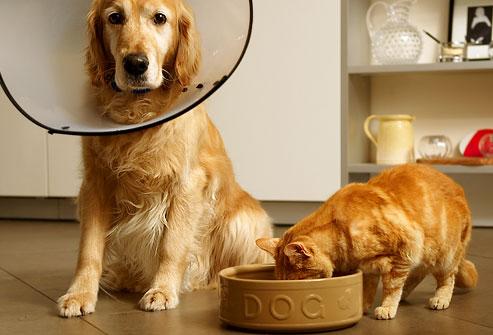In modern society, we understand the importance of quality food. to maintain and improve our health. We know that must eat good quality food in a certain amount to maintain balance and optimal health. Today this the question also applies to pets. Many pet owners they have been relying on commercial feeds for decades, containing nutritious and balanced ingredients but the counter-movement, which avoids such approach to feeding. Proponents of both methods are equally convinced that their approach is better.

Do dogs and cats have special nutritional requirements?
Contents
- 1 Do dogs and cats have special nutritional requirements?
- 2 What are the advantages and disadvantages of commercial feed?
- 3 What you need to know about pet food labeling?
- 4 What are the benefits of home cooked food?
- 5 What you need to know about pet feeding cooked food?
- 6 Are there any risks of feeding the animal home food?
- 7 How to minimize possible risks?
- 8 What symptoms and diseases can be treated with home food?
In general, cats are obligate animals, and require large part of their diet was meat. Dogs are predators optional, i.e. can eat various foods containing meat, grain, vegetables, herbs, etc. Due to its physiological differences, dogs and cats have specific requirements for certain essential acids (protein components) and other nutrients. For example, cats require a relatively high taurine level compared to dogs to stay healthy.
The ideal food for cats is raw, such as a mouse or bird, which they can eat almost entirely. Ideal food for the dog is fresh prey supplemented with fresh herbs, fruits, vegetables, or seasonal berries. However, such a choice is either socially unacceptable or inappropriate for most pets. Our goal is to choose another most suitable diet for the animal.
The breed and functions of animals should also be considered when choosing optimal diet. Different breeds of dogs that have been proven have various abilities to assimilate certain foods. Breeds that have been bred in a particular climate, such as the Arctic, beyond the Arctic Circle, they are well assimilating the diet that is common and common in their places of origin. Workers animal breeds (hunting and cattle dogs, cats at exhibitions) require different ratios of proteins and fats in their diets. Mixed breeds may require further individualization. pet ration in order to optimize nutritional balance substances.
What are the advantages and disadvantages of commercial feed?
No doubt commercial feeds are more convenient in use when it’s easy to get acquainted with the basic requirements to prevent apparent nutritional deficiencies. Good and proven brands, especially premium feeds, really provide a pet suitable and adequate nutrition. In testing these feeds, large groups animals ate certain foods and remained healthy on different stages of their life.
Pet food may contain suboptimal ingredients, and, in such cases, these feeds are often added certain supplements to make the diet respond to basic food needs. Processing can also further degrade quality. nutrients. This way manufacturers can add some additives and nutrients after treatment, thereby compensating for all possible losses.
All pet foods must contain a certain amount of preservatives to extend their shelf life. Wet feed contains the highest level of preservatives, but immediately after them followed by dry feed. Products that have a short shelf life storage, usually have the least amount of preservatives, or various “natural preservatives,” such as vitamins C or E. But these vitamins are quickly oxidized after opening the package and disintegrate, which often leads to an unpleasant taste and smell.
Animal feeds are based on specific formulas, recommended by international organizations. However, these formulas may not be suitable in all cases, as they are designed based on general principles of nutrient bioavailability and not leave errors for breed differences, for different digestion disorders, or changes in the physiology of the animal with some diseases. General feed formulas are intended as usually to provide adequate nutrition for an average healthy animal.
The last concern is dry cat food. These feed often applied without restriction, which may lead to development obesity due to excessive consumption of carbohydrates. There are some assumptions that excess carbohydrates in cats may significantly increase the risk of developing their diabetes. Besides of this, cats that eat exclusively dry food, more predisposed to the development of diseases of the genitourinary system, such as the formation of crystals in urine (urolithiasis).
What you need to know about pet food labeling?
Currently, animal feed is required to indicate only their chemical composition, which does not necessarily mean digestibility of these substances. For example, skin, muscle meat, soy protein – all are mostly protein but different quality and digestibility. Labeling that claims to feed “without preservatives” does not mean that they are not in it, it is only means the manufacturer does not add any preservatives. Besides of this, preservatives can be added to feed suppliers manufacturer. Food and preservative-free foods are usually have a very short shelf life, unless they are are frozen.
What are the benefits of home cooked food?
Homemade Animal Feed Supporters Highlight the importance of including a variety of fresh and whole foods in your diet to maintain health.
The benefits of a home diet include your confidence in freshness and quality of ingredients (especially if you use natural products), as well as the ability to add important nutritional supplements, including dietary supplements. Many dogs and cats there is an improvement in the condition of hair, skin and an increase in the level activity. An exception to this rule is animals with allergic to one or more ingredients in their diet.
What you need to know about pet feeding cooked food?
Home-cooked food must be properly balanced to maintain animal health. Optimal a way to avoid nutrient deficiency or excess is to use special recipes that meet all the requirements feeding the animal. To avoid the disadvantages of certain different types of nutrients are recommended proteins, vegetables and grains. In many recipes, the ingredients can replace with similar ones, thereby simplifying their preparation.
Since meat and many vegetables contain too little calcium, it is important to add calcium supplements to any homemade food. Most pet diets include vitamin and mineral supplements. If these additives are added before cooking food, then they can become denatured and ineffective. This The problem often arises with many vitamins.
Are there any risks of feeding the animal home food?
The ratio of the individual components in homemade food can vary significantly therefore if you stick one recipe, this can lead to serious imbalances nutrients. You should also avoid complicated recipes and dishes that take too long to cook. But, however, not enough feed the animal just scraps of meat, some cereal and vegetables cooked in a hurry and thrown into his bowl, as this will ultimately lead to malnutrition.
Problems can also arise if there are certain vitamin supplements are greatly overstated or underestimated or minerals. The most common imbalance in homemade food observed in calcium, phosphorus, zinc, magnesium and iron. Growing animals need a special diet with plenty of nutrients high in protein and optimal ratio of vitamin and mineral supplements to maintain growth.
Advice and advice from a veterinarian with advanced nutritional knowledge can be very important to reduce or prevent these possible risks to the animal.
Some popular pet diet authors recommend feeding without cereals (without carbohydrates), as well as feeding raw meat, or completely raw food with bones. Most studies suggest that healthy animals are resistant to bacterial pathogens contained in purchased meat. It is also believed that animals can digest without problems. crushed raw bones.
However, animals with impaired health may be susceptible to certain diseases caused by bacteria. Raw bones should be included in the diet very carefully depending on their the size and size of the animal. Too large bones can cause intestinal obstruction. Should never be given to an animal cooked bones, as they are fragile and can also lead to obstruction of the gastrointestinal tract.
How to minimize possible risks?
You should openly discuss your pet’s diet with your veterinarian, including any goodies and nutritional supplements. Regularly Examine your pet for any early symptoms of possible problems.
Since animals age faster than humans, good advice Will undergo a full medical examination every six months. AT in addition to physical examination, it is advisable to take biochemical analysis and blood analysis. Periodic radiographs can serve to assess the density and structure of bones, which will allow detect developing calcium deficiency.
What symptoms and diseases can be treated with home food?
Symptoms such as severe molting, itching, skin lesions, digestive disorders, allergy to commercial ingredients feed can be successfully treated with homemade food. Animals with special dietary needs or health problems can show a significant improvement in their condition if their the diet was specifically designed to meet their needs.






